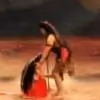here read the beautiful Bhartiya sanskriti
I am sure you all will have gooseberries on you reading this well be proud to be bhartiyas 😃
Two Dynasties and Two Epics
The two Epics Ramayan and Mahabharat tell the stories of Ancient Bharat and these two also describe in details the achievements of two great dynasties that shaped our history. These two dynasties were Suryavansha and Chandravansha. The Chandravansha ruled in the region between Ganga and Yamuna, that included the present day Delhi, Haryana, Western U.P., and the Suryavansha in Ayodhya. These two dynasties gave birth to able rulers, sages, law-makers, warriors and through matrimonial alliances, they were connected with almost all the dynasties of Bharat. The Suryavansha was the oldest and its founders were Vivaswan and his son Vaivasvat Manu. The real history starts from their descendant Ikhsvaku, in whose line born great kings like Sagar, Raghu, Sri Rama etc. After the death of Sri Rama, his kingdom got divided among his two sons ( a similar fate happened to the kingdom of Solomon ). Their descendants continued to rule till the rise of the Nandas. The Suryavansha was connected to Chandra through matrimonial alliance. Ila, the daughter of Manu was married to Budha, the son of Chandra, from whom descended the famous Pururava Aila. Among the early rulers, Nahusha and his son Yayati were famous. Yayati married the daughter of Sukracharya. His sons spread in all directions. Among them Puru succeeded him, while Jadu set up his own kingdom. The descendants later engaged in a battle, known as the Battle of Ten kings. Among the later rulers, kuru gave his name to the kuru country, and the line continued till the Mahabharat War. While Mahabharat describes the achievements of the Lunar Dynasty, Ramayana concentrates on the Solar one. However, both these dynasties played important role in the development of Bharatiya culture. We know that the name Ilavarta is an ancient name of Aryavarta, and named after Ila, while Bharatvarsha was named after Samrat Bharat and his descendants. The kuru-Panchala country was famous for Vedic studies and River Saraswati was within the rule of the kurus. While Sanatan Dharma and its traditions developed in the kuru-Panchala region, the kosala kingdom was famous for smritis or laws. Hence the division between Smriti and Shruti appeared. The Vedas and Sanatan Dharma which remained constant with the change of time, is called Shruti ( to be heard ). The Dharmashastras or law-books that change with the change of time, is called Smriti ( to be remembered ). The latter represent Yuga Dharma, different from Sanatan Dharma. Later the Brahmanas started to settle in the Videha ( North Bihar ), where a branch of the Ikshvaku dynasty ruled. A branch of it also settled in South kosala and Andhra. The Ikshvakus were famous for their justice, unlike the Purus who were famous for warfare and expansion. The tradition of Manus was connected with Suryavansha, who was also connected with the Sakyas. Both these dynasties performed Asvamedha, Rajasuya and Vajapeya sacrifices. The traditional capital of the Chandras was Pratisthana ( Prayag ). Later Hastinapur became their capital. The Chandra princes married Yavana women and thus gave birth to different Yavana tribes. The Persians also descended from the line of Yayati. The region of Uttar kuru, Balhika, Gandhara etc were colonized by the Chandras. They also built beautiful palaces and towns. Both kuru and kosala excelled other states in the system of alliances. We find many such alliances in Epics. The most important was the alliance of Rama with the Vanaras against the Rakshasa kingdom. Another important alliance was the Pandava-Yadava alliance or friendship of Arjun and krishna against the ruling kauravas. Like the Greek Epic War, these alliances played important role in Ancient Bharatiya politics. During the Mahabharat Period, the Devabhumi Himalaya was not forgotten. This was the traditional homeland of Sanatan Sanskriti. So the journey of Yudhisthira ended in the Himalayas where all his mighty brothers fell one by one. The city of krishna also merged in the water. Arjun witnessed the destruction of Dwarka by rising sea and then before his eyes Dwaraka was no more. It vanished in the seas. This was the message of Mahabharat-nothing exists forever. Too much pride and over-confidence led to the destruction of kuru culture. Then the Mlecchas started to multiply and the kali Era began. The magical world of Vedic Bharat ended with the decline of these two dynasties. The Rajputs later claimed their origins from both these houses. Still the Epics of Valmiki and Vyasa fascinate us. We could not forget what we once were and what we have become. Those who are interested in detailed study, may contact Jijith N. Ravi, who created Ancient Voice, a site on Mahabharat. Similar efforts like Hindu Wisdom by an America-based woman led us to the past. But of all these sites, Ancient Voice is the most helpful because of its perfect research and analysis. It put emphasis on political history with minute details. I thank the creator of Ancient Voice, Jijith, for his hard work.


























